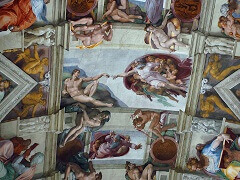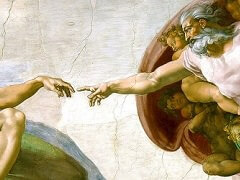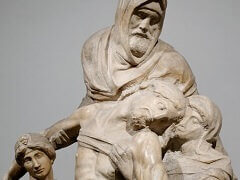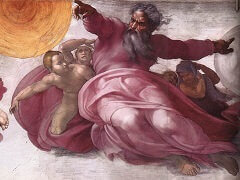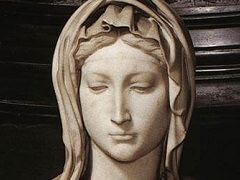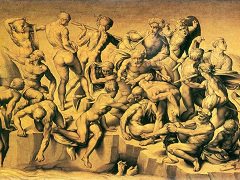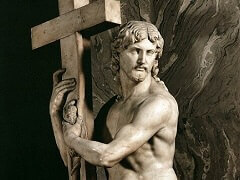David, by Michelangelo

Michelangelo's Statue of David is the perfection of the most famous sculpture in Florence and, perhaps, in all the world.
In 1501 Michelangelo was commissioned to create the David by the Arte della Lana (Guild of Wool Merchant), who were responsible for the upkeep and the decoration of the Cathedral in Florence.
Traditionally, David was portrayed after his victory, triumphant over Goliath. But Michelangelo breaks away from the traditional way of representing David. He does not present us with the winner, the giant's
head at his feet and the powerful sword in his hand, but portrays the youth in the phase immediately preceding the battle: perhaps he has caught him just in the moment when he has heard that his people are hesitating,
and he sees Goliath jeering and mocking them.
The marble block from which Michelangelo hoped to create the colossal David statue most likely came from the quarry of the Fantiscritti in the Miseglia district of Carrara, which is confirmed by recent petrographic analysis. As for the marble itself, the artistic literature reports that it had already been carved on two different occasions by two different sculptors, including Donatello. It seems that both sculptors had stopped carving the marble owing to its poor quality and brittleness, but in the meantime they had done some work on its parallelepiped shape, so that when Michelangelo got it, certain binding decisions may already have been made: the space where the legs were to spread apart, the notching or partial depression in the shoulder area. The block must have had some recognizable anthropomorphic trait as it had already earned itself the name of "giant" even before Michelangelo began working on it. Besides the intrinsic weakness of the marble, there were other elements which interfered with its aesthetic aspect: the veins running throughout the block and countless taroli, or pinholes, riddling the surface.
According to Michelangelo's biographer Ascanio Condivi, Michelangelo worked at the statue in utmost secrecy, hiding his masterpiece in the making up until January 1504. It is said he created a wax model of his design, and submerged it in water. As he worked, he would let the level of the water drop, and using different chisels, sculpted what he could see emerging. He slept sporadically, and when he did he slept with his clothes and even his boots still on, and rarely ate.
The David strikes a simple pose: given its size, any stronger action pose risked compromising balance. At all events, it was an extraordinary accomplishment to have extracted so nobly and animated a figure out from such a disproportionately flat rectangular mass. Supporting his body with the right leg and carrying the left leg forward, the almost divine young hero lets his right-hand fall to the thigh level as he flexes in the other to shoulder height. His face is bold yet thoughtful: he is defiantly awaiting his adversary and calmly sizing up his chances like a true Florentine as he plans an attack of questionable loyalty.
Although the marble was originally part of a project by Santa Maria del Fiore, it had not been decided from the outset that the statue would be included in the cathedral ornamentations; in fact, its final destination was decided in the spring of 1504 by a committee that was made up of the most eminent artists in Florence at the time: Leonardo da Vinci, Sandro Botticelli, Giuliano da Sangallo, Cosimo Rosselli, Piero di Cosimo, Filippino Lippi, Andrea della Robbia, Pietro Perugino. While Botticelli was the only one who wanted to locate the David in the vicinity of the cathedral, all of the others agreed that it should be installed in Florence's most representative piazza, in front of the Palazzo della Signoria (now called Palazzo Vecchio).
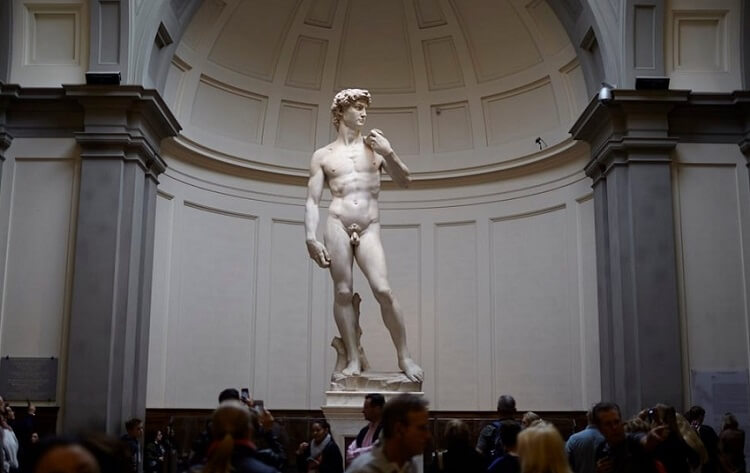
Michelangelo's David not only embodies the aesthetics of High Renaissance art, the politics of Renaissance Florence, and the technical virtuosity of Greek sculpture, but also has become one of the most recognized works of Renaissance sculpture, becoming a symbol of both strength and youthful human beauty.
10 Secrets of Statue of David by Michelangelo
1. Michelangelo's David is massive at 17 feet tall and more than 12,000 pounds, yet it is sculpted from a single block of white marble.
2.The block of marble that Michelangelo used to carve "David" had been worked on more than 50 years earlier by Donatello. At that time the marble was said to have had a
flaw in it and the project was abandoned.
3.Michelangelo broke with artistic tradition by portraying David before his battle with Goliath rather than afterwards as seen in representations by Caravaggio and Donatello.
4. Unruly protesters flung a chair that broke the statue's left arm in three spots during an uprising in 1527.
5. In 1857, reigning Queen Victoria was so taken aback by the nudity of a replica David statue that she ordered a plaster fig leaf to be cast to cover his genitals before he went on display at
the Victoria and Albert Museum in London.
6. Although it has remained in Florence for over 500 years, the Italian government recently asked the courts to decide whether the city or the country owns the David.
7. Michelangelo exaggerated the size of David's right hand. Some believe it is a reference to a nickname for the biblical David, which means "strong of hand."
8.That David's eyes are flawed went unnoticed for centuries, perhaps due to the statues' extreme height. However, the 20th-century Digital Michelangelo Project at Stanford University
rendered complete images of the statue which revealed that the David's left eye gazes forward while the right eye is focused on some distant spot.
9.In 1873, officials decided to move the David indoors to the Galleria dell'Accademia to protect it from the weather. However, the statue is now suffering from stress fractures caused
by the vibrations of scores of tourists filing past.
10. Moving the statue from Michelangelo's studio to the Palazzo Vecchio took forty men and four days, even though the distance was less than a mile.


